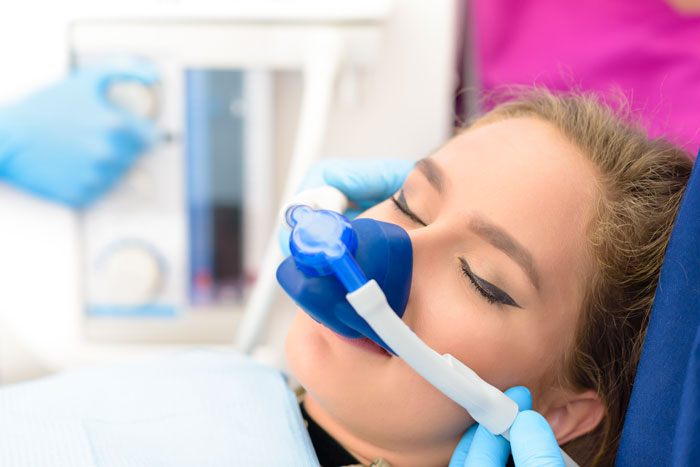The Difference Sedation Dentistry Can Make
 Many people have endured the pain of a toothache because they fear to go to the dentist for treatment. The good news though is there is a solution to your fear of dental procedures, and that is sedation dentistry. In the past sedation dentistry wasn’t used as much as today or it was limited to only a couple of forms.
Many people have endured the pain of a toothache because they fear to go to the dentist for treatment. The good news though is there is a solution to your fear of dental procedures, and that is sedation dentistry. In the past sedation dentistry wasn’t used as much as today or it was limited to only a couple of forms.
Thanks to technology and innovations you can now have an array of sedation treatment to choose from and have a peaceful dental procedure done.
Sedation Dentistry
It is the branch of dentistry that uses medication to help patients feel comfortable and relaxed during a dental procedure. Sedation dentistry can be administered either orally, by injection, or inhalation and it will all depend on the dental process and the patient’s level of anxiety.
Sedation dentistry has made dental procedures to be possible and eliminated the pain that might experience during a dental process. In the beginning sedation, dentistry used nitrous oxide with the absence of oxygen. This method of sedation wasn’t yielding desired results and had to be improved further by adding oxygen.
As time went by sedation dentistry improved by introducing more methods that were effective and convenient to meet the rising demands of dental procedures.
Are You Qualified to Have Sedation Dentistry?
Sedation dentistry is suitable for both children and adults. It doesn’t matter what dental care you are getting done sedation dentistry will always be there to save the day. Adults are not the only ones who have a fear of dental procedures, children can experience the same kind of fear.
Sedation dentistry is used whenever you are having multiple dental procedures done on you on the same day. Gag reflex has been a hindrance during dental processes, and if you have a problem with your gag reflex, your dentist might administer sedation to help manage it.
Who Can Administer Sedatives in Dentistry?
Sedation dentistry is divided into several levels, and there are some which can only be administered by a specialist such. Your dentist can apply a mild to moderate form of sedation. He/she can use the services of a dental anesthetist who has the expertise in administering all types of dental anesthesia.
Types of Sedation Dentistry
There are different types of sedation dentistry, and the level of sedation medication used depends on the type of procedure being done.
Inhaled Sedation
Because of its mild nature, this type of sedation is best for kids. It is a combination of nitrous oxide and oxygen which a patient is supposed to inhale before a procedure starts. Inhaled sedation wears down fast.
Oral sedation
It is in the form of a pill which is swallowed an hour before the procedure begins. Depending on the dental work being done on you the dosage can be increased or reduced. It doesn’t make you utterly unconscious as you’ll have feelings of drowsiness but be half awake.
Everybody reacts differently with sedation and some people fall asleep with oral sedation but can be awakened by shaking them gently. Oral sedation takes time to wear off, and you will need someone to drive you home after your appointment.
IV sedation
Intravenous sedation is usually administered through the veins and can be used in a moderate form. Its effect is quicker than the oral and inhaled sedation, and the dentist can regulate the doses during a procedure.
Numbing of the area being treated is done by administered local anesthesia before work begins. Local anesthesia is used together with the other forms of sedation.
Importance of Sedation Dentistry To The Dentist And Patient
Sedation is beneficial to the dentist as well as the patient. When the patient is relaxed and comfortable, the dentist is also relaxed and can work with a clear mind and less distraction. So, here are some of the benefits you and your dentist get from sedation dentistry.
Time-Saving
Sedation dentistry keeps you calm, and the dentist can work without interference and faster. Whenever a patient is anxious, they move and tilt more often, and this movement slows down the dentist.
Reduced Gag Reflex
The gag reflex is an essential part of the body and helps to eliminate any foreign materials in the oral cavity. When a patient is fully awake, their gag reflex is also at work, and sometimes the dentist is required to perform a procedure deeper in the oral cavity.
The gag reflex becomes a standing block since it will be pushing anything that wants to get access to the oral cavity. When a patient has sedative administered the gag reflex relaxes and allows the dentist to perform a procedure with ease.
Provides Comfort
When the patient is relaxed, it means he/she is comfortable and less anxious. Sedation dentistry will provide the support needed during dental work, and the patient will be calm throughout the procedure.
Reduced Dental Appointments
With sedation dentistry in place, you can have multiple dental procedures done on the same day. Sedation dentistry saves you the time you could have used going back to the dentist for dental procedures.
Eliminates Pain
Sedation dentistry blocks pain messages from being communicated to the brain, and this helps to reduce pain. When a patient perceives any pain during dental work, they become restless and move, and this makes the dentist also anxious and works slower.
You have no reason to fear any dental procedure because of anxiety or pain, sedation dentistry will help calm you done and have a healthy oral life.

